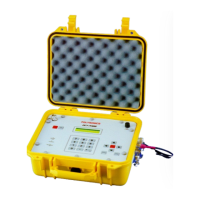7088-8000
-10
1.3 Transit Time Accuracy
Non-invasive ultrasonic measurements are subject to a variety of effects that can influence
measurement accuracy. All ultrasonic instruments are velocity measuring devices and only
infer volumetric flow from the operator entered parameter of pipe inside diameter (ID). As
this value is squared to get cross-sectional area, a 1% error yields a 2% error in volumetric
flow. In practice, commercially fabricated pipe seldom has ID consistency much tighter
than 1% and, unless the pipe to be measured has been miked recently, this uncertainty is
not reducible through instrument calibration.
The more sophisticated transit time flowmeters incorporate flow profile corrections to
compensate for the pipe's cross-sectional velocity profile with changing Reynolds number.
This requires, however, that the roughness of the inside of the pipe to be measured is
known. The instrument may well infer a roughness if none is entered by the operator, but
that is only a guess based on the characteristics of new pipe. Pipes can, of course,
accumulate deposits which may not only reduce the ID, but affect the roughness as well.
Errors on the order of 2% as a result of this phenomenon are not uncommon.
While other factors may influence instrument accuracy to a lesser extent, the issues
described above are the major elements of the pipe dependency of absolute instrument
accuracy. While calibration on a reference flow loop under known conditions is a useful
exercise to determine the accuracy potential of an instrument, it is not a guarantee of
absolute accuracy on different pipes under field conditions.
1.4 Operating the Flowmeter
The flowmeter must be configured and the transducers must be properly spaced and
installed in order for the flowmeter to detect ultrasonic signals and measure flow. The
flowmeter can be quickly set up for operation by following the minimal steps listed in the
Quick Setup procedure (Section 3.5). The flowmeter should also be calibrated for the
specific site if accuracy at very low flow rates is important (Chapter 5).
1.4.1 RS232 PORT
The flowmeter can be configured and monitored locally with the integrated keypad and
display or remotely through the RS232 port. RS232 communications with the flowmeter
requires an IBM-compatible PC and the PolyLink or
TimeGATE
™
flowmeter utilities. In
addition to remote monitoring and configuring functions, PolyLink allows data log files to
be transferred to the PC. These files can then be imported into a word processor, a
spreadsheet, or simply printed out. Refer to Appendix A for more information on PolyLink
and to Appendix F for more information on
TimeGATE
™
.

